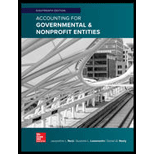
Accounting For Governmental & Nonprofit Entities
18th Edition
ISBN: 9781259917059
Author: RECK, Jacqueline L., Lowensohn, Suzanne L., NEELY, Daniel G.
Publisher: Mcgraw-hill Education,
expand_more
expand_more
format_list_bulleted
Textbook Question
Chapter 17, Problem 15.7EP
Which of the following is a correct mathematical relationship among proprietary account balances?
- a. Net Position equals Total Assets minus Total Liabilities.
- b. Fund Balance with Treasury equals Unexpended Appropriations.
- c. Cumulative Results of Operations equals Revenues and Financing Sources minus Operating/Program Expenses.
- d. Disbursements in Transit equals Fund Balance with Treasury minus Accounts Payable and Other Current Liabilities.
Expert Solution & Answer
Want to see the full answer?
Check out a sample textbook solution
Students have asked these similar questions
Net income general
None
At the end of February 2016
Chapter 17 Solutions
Accounting For Governmental & Nonprofit Entities
Ch. 17 - Prob. 1QCh. 17 - Prob. 2QCh. 17 - Prob. 3QCh. 17 - Prob. 4QCh. 17 - Prob. 5QCh. 17 - Prob. 6QCh. 17 - The federal government uses two groups of funds....Ch. 17 - Prob. 8QCh. 17 - Prob. 9QCh. 17 - Prob. 10Q
Ch. 17 - Prob. 12CCh. 17 - Prob. 13CCh. 17 - Access the most recent Financial Report of the...Ch. 17 - Prob. 15.1EPCh. 17 - Prob. 15.2EPCh. 17 - Prob. 15.3EPCh. 17 - Prob. 15.4EPCh. 17 - Prob. 15.5EPCh. 17 - Prob. 15.6EPCh. 17 - Which of the following is a correct mathematical...Ch. 17 - Which of the following is not a component of a...Ch. 17 - Fund Balance with the Treasury would be considered...Ch. 17 - Prob. 15.10EPCh. 17 - Which of the following federal funds is most...Ch. 17 - Following is a list of a number of accounts used...Ch. 17 - One amount is missing in the following trial...Ch. 17 - Use the data from Problem 1717 for this...Ch. 17 - Prob. 19EPCh. 17 - Prob. 20EPCh. 17 - Congress authorized the Flood Control Commission...Ch. 17 - Prob. 22EP
Knowledge Booster
Learn more about
Need a deep-dive on the concept behind this application? Look no further. Learn more about this topic, accounting and related others by exploring similar questions and additional content below.Similar questions
arrow_back_ios
SEE MORE QUESTIONS
arrow_forward_ios
Recommended textbooks for you
 Intermediate Accounting: Reporting And AnalysisAccountingISBN:9781337788281Author:James M. Wahlen, Jefferson P. Jones, Donald PagachPublisher:Cengage Learning
Intermediate Accounting: Reporting And AnalysisAccountingISBN:9781337788281Author:James M. Wahlen, Jefferson P. Jones, Donald PagachPublisher:Cengage Learning

Intermediate Accounting: Reporting And Analysis
Accounting
ISBN:9781337788281
Author:James M. Wahlen, Jefferson P. Jones, Donald Pagach
Publisher:Cengage Learning

Accounting Basics Explained Through a Story; Author: Leila Gharani;https://www.youtube.com/watch?v=VYNTBWBqncU;License: Standard Youtube License